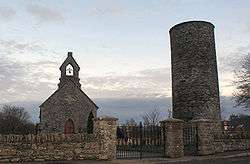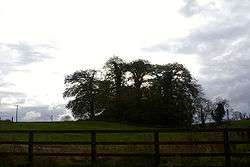Inniskeen
| Inishkeen Inis Caoin | |
|---|---|
| Town | |
 Inishkeen Location in Ireland | |
| Coordinates: 54°00′00″N 6°35′35″W / 54.000°N 6.593°WCoordinates: 54°00′00″N 6°35′35″W / 54.000°N 6.593°W | |
| Country | Ireland |
| Province | Ulster |
| County | County Monaghan |
| Elevation | 57 m (187 ft) |
| Population (2011) | |
| • Urban | 265 |
| Time zone | WET (UTC+0) |
| • Summer (DST) | IST (WEST) (UTC–1) |
Inniskeen, officially Inishkeen (Irish: Inis Caoin, meaning "peaceful island"),[1][2] is a small village and parish in County Monaghan, Ireland, close to the County Louth and County Armagh borders. It is located about 17 km from Dundalk, 12 km from Carrickmacross, and 5 km from Crossmaglen.
History

This territory had been inhabited from the late Neolithic/Early Bronze Age. Rock art carvings (Petroglyphs) have been discovered in adjoining townlands (including Drumirril) dating to 3000 BC. Cup and ring markls with concentric circles are the main inscriptions.[3] They have been excavated by UCD School of Archaeology.[4] Finds on the site ranged from late Neolithic to the early Christian period. These included ancient cooking places known as Fulachta Fiadh. Unlike Newgrange the carvings are on the bedrock and not part of a constructed monument. It is not open to public viewing, A Bronze Age cyst grave was also discovered in Inniskeen Glebe townland.
A monastery was founded here in the 6th century by Saint Daigh MacCarell which was burned in 789, plundered by the Vikings in 948, and burned a second time in 1166. The bottom third of the round tower remains. In this drumlin country many of the hill tops have hill forts and associated souterrains which date from the late Iron Age or early Christian era. The country was part of McMahon Clann territory who displaced Carrolls in the 9th century as the dominant force in the area.

The arrival of the Normans saw the construction of a motte-and-bailey in the 13th century. The motte is still standing. The arrival of the Augustinian order of monks saw the construction of a new monastery of that order as a branch of the Abbey at Louth. One section of its wall remains adjoining the graveyard in the field adjoinhing the Motte.
The 2nd Earl of Essex was granted the Barony of Farney, including Inniskeen, by Queen Elizabeth I of England in the late 16th century. These lands devolved to Viscount Weymouth. The Marquess of Bath sold this estate to the tenants in the 1880s under the land Acts.
In 1806, the first record of Hurling/Football in Inniskeen as Monaghan beat Louth in a match that is celebrated in the Irish poem Iommain Iniis Chaoin.
The GNR(I) Inniskeen railway station opened on 1 April 1851, closed for passenger traffic on 14 October 1957 and finally closed altogether on 1 January 1960.[5] It was on the Dundalk to Enniskillen line was a junction for the Carrickmacross line.
More recently, during The Troubles in Northern Ireland, because it is adjacent to Crossmaglen, many people were involved with the Provisional IRA campaign.
Patrick Kavanagh Centre
The Patrick Kavanagh Centre is set up to commemorate the poet Patrick Kavanagh.The Centre houses exhibitions outlining Kavanagh's lifestory and local history. It is located in the former St. Mary's Church, a former Catholic church, in whose adjoining graveyard Kavanagh and his wife are buried.[6]
Sports clubs
Inniskeen's Gaelic Athletic Association club is called the Inniskeen Grattans. It was founded in 1883 predating the founding of the GAA in 1884.[7] Its jersey colours are red and green. The club opened a new stadium in 2008. They won the first County Championship, in August 1888, beating Carrickmacross by 0–7 to 0–0. They later played Cavan champions Maghera Mac Finns in the first Ulster final in Drogheda which ended in a draw, but won the replay December making it the first ever Ulster S.F. champions. It won the Senior Championship Final also in 1905, 1938, 1947 and 1948. In 2005 the club won the Monaghan (beating Doohamlet) and Ulster Intermediate Club Football Championships after def. In the Monaghan Championship defeating Doohamlet 1–13 to 2–9 in Clontibret and in Ulster, defeating Glenswilly in Enniskillen. The club were defeated in the Senior Hurling Shield final by Clontibret in Monaghan. Inniskeen was represented by Fergal Duffy when Monaghan won the National League Div. 2 in Croke Park. In 2006 Inniskeen won the All-Ireland Intermediate Club Championship by defeating Caherlistrane GAC in Croke Park, 2–10 to 1–11.
Inniskeen Pitch & Putt club has an 18 hole course on the banks of the Fane.
People
- Birthplace and childhood home of Patrick Kavanagh (1904 – 1967), who is regarded as one of the foremost Irish poets of the 20th century. He is buried in Inniskeen graveyard.
- Birthplace of Dr. Peter Kavanagh (1916 – 2006), brother of Patrick, writer, scholar and publisher, who collected, edited, and published the works of Patrick Kavanagh. He is buried in Inniskeen graveyard.
- William P Quinn (1900–1978) was the first Commissioner of the Garda Síochána to rise through the ranks from ordinary Garda when he was appointed in February 1965.
- Oliver Callan, satirist and comedian from RTÉ Radio One programme Callan's Kicks.
- The Most Rev. Dr Heber MacMahon (1600-1650), Lord Bishop of Clogher, commander of the Catholic Confederate forces at the Battle of Scarrifholis, fought near Letterkenny in East Donegal, in 1650.
See also
- List of towns and villages in Ireland
- List of abbeys and priories in County Monaghan
- Inniskeen Past and Present
References
- ↑ Placenames Database of Ireland
- ↑ Ordnance Survey Ireland - Online map viewer
- ↑ http://www.mythicalireland.com/ancientsites/drumirril/index.html
- ↑ http://www.ucd.ie/archaeology/staff/post-doctoral/drblazeoconnor/research/
- ↑ "Inniskeen station" (PDF). Railscot - Irish Railways. Retrieved 2007-10-16.
- ↑ http://www.patrickkavanaghcountry.com/html/pkcentre.htm
- ↑ http://inniskeen.monaghan.gaa.ie/125history.html
External links
- Google Satellite Images of Inniskeen
- Inniskeen Grattans GAC website
- St Daigh's National School project
- Hearth Rolls Hearth Money Rolls for Inniskeen parishe 1663–1665
- 1911 Census records of Inniskeen
- description from Lewis's Topographical Dictionary of Ireland, 1837
| ||||||||||||||||||||||||||
